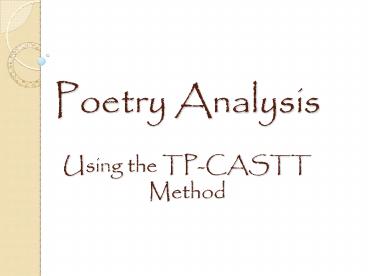Poetry Analysis Using the TP-CASTT Method - PowerPoint PPT Presentation
1 / 12
Title:
Poetry Analysis Using the TP-CASTT Method
Description:
Poetry Analysis Using the TP-CASTT Method What is TP CASTT? An acronym of steps used to analyze poetry. The results of TPCASTT can be used to write an essay. – PowerPoint PPT presentation
Number of Views:295
Avg rating:3.0/5.0
Title: Poetry Analysis Using the TP-CASTT Method
1
Poetry AnalysisUsing the TP-CASTT Method
2
What is TP CASTT?
- An acronym of steps used to analyze poetry. The
results of TPCASTT can be used to write an essay. - The TPCASTT process is comprised of 7 steps which
should be completed in the order given.
3
How does TPCASTT work?
- The TPCASTT method is used to analyze poetry for
some reason specified by the analyst. - The analyst will
- Observe
- Interpret
- Infer
- Analyze
- Evaluate
4
Step 1 TitleGoal- Attempt to predict what the
poem will be about
- Ponder the title before reading the poem.
- Questions to ask yourself
- What predictions can I make about the poem
- What feelings can I connect to the poems title?
- Write your response in a complete sentence
5
Step 2 ParaphraseGoal- Translate the poem, line
by line, into your own words.
- Paraphrase the literary meaning/plot of the poem.
A true understanding of the poem must evolve
from comprehension or whats going on in the
poem.
6
Step 3 ConnotationGoal- Contemplate the poem
for meaning beyond the literal meaning.
- In poetry, connotation indicates that analyst
should examine any and all poetic devices,
focusing on how such devices contribute to the
meaning, the effect, or both of a poem. - Consider imagery, figurative language, symbolism,
diction, point of view, and sound devices - You will link these considerations to the overall
meaning.
7
Step 4 AttitudeGoal- Observe both the speakers
and the poets attitude
- Having examined the poems devices and clues
closely, now explore the multiple attitudes that
may be present in the poem. - Here you will describe the tone of the author
and/or speaker. Recall how this is done
8
Step 5 ShiftsGoal-Note shifts in the speakers
attitudes or emotions.
- Rarely does a poet begin and end the poetic
experience in the same place. Discovery of a
poets understanding of an experience is critical
to the understanding of the poem. Trace the
feelings of the speaker from the beginning to the
end, paying particular attention to the conclusion
9
Look for the following to find shifts
- 1. Key words (but, yet, however, although)
- 2. Punctuation (dashes, periods, colons,
ellipsis) 3. Stanza division - 4. Changes in line or stanza length or both
- 5. Irony (sometimes irony hides shifts)
- 6. Effect of structure on meaning
- 7. Changes in sound (rhyme) may indicate changes
in meaning - 8. Changes in diction (slang to formal language)
10
Step 6 TitleGoal-Examine the title again, this
time on an interpretive level
- Questions to ask yourself
- Why is the title _____?
- What does this mean?
11
Step 7 ThemeGoal- Determine what the author is
saying and wants me to learn and feel after
reading the poem.
- Identify the theme by recognizing the human
experience, motivation, or condition suggested by
the poem - This step, within itself, has a system
- Summarize the plot
- List the subject (s) of the poem (moving from
literal subjects to abstract concepts such as
war, death, discovery) - Determine what the poet is saying about each
subject. Write a complete sentence, making a
statement and point about the subject (s).
12
Example of theme explication using the poem
Janet Walking
- Plot In Janet Walking Janet awakens one
morning and runs to greet her pet chicken only to
discover that a bee had stung and killed the
bird. The discovery desolates Janet to such a
degree that her father cannot comfort her. - Subjects
- 1. A childs first experience of death
- 2. loss of a pet
- 3. innocence
- Themes
- 1. Children become aware of the inevitability
of death and are transformed by the knowledge.
- 2. The death of innocence is inevitable































